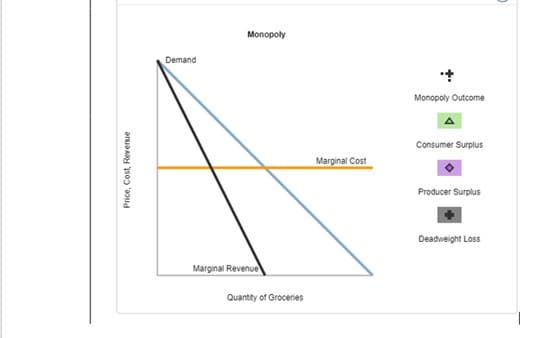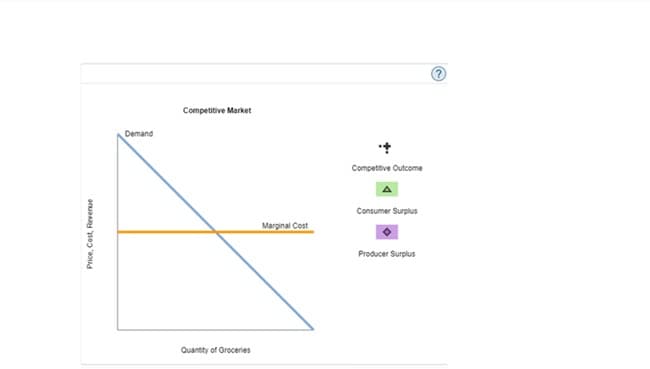10 . Competitive Supermarkets A small town is served by many competing supermarkets, which all have the same constant marginal cost. Use the black point (plus symbol) to show the competitive price and quantity in this market. Then use the green area (triangle symbol) to shade the area representing consumer surplus in the market for groceries, and use the purple area (diamond symbol) to shade the area representing producer surplus.
10 . Competitive Supermarkets A small town is served by many competing supermarkets, which all have the same constant marginal cost. Use the black point (plus symbol) to show the competitive price and quantity in this market. Then use the green area (triangle symbol) to shade the area representing consumer surplus in the market for groceries, and use the purple area (diamond symbol) to shade the area representing producer surplus.
Managerial Economics: A Problem Solving Approach
5th Edition
ISBN:9781337106665
Author:Luke M. Froeb, Brian T. McCann, Michael R. Ward, Mike Shor
Publisher:Luke M. Froeb, Brian T. McCann, Michael R. Ward, Mike Shor
Chapter3: Benefits, Costs, And Decisions
Section: Chapter Questions
Problem 3.6IP: Dropping University Courses Students doing poorly in courses often consider dropping the courses....
Related questions
Question
10 . Competitive Supermarkets
A small town is served by many competing supermarkets, which all have the same constant marginal cost.
Use the black point (plus symbol) to show the competitive price and quantity in this market. Then use the green area (triangle symbol) to shade the area representing consumer surplus in the market for groceries, and use the purple area (diamond symbol) to shade the area representing producer surplus .
Now suppose that the independent supermarkets combine into one chain.
Use the black point (plus symbol) to show the profit-maximizing monopoly outcome. Then use the green area (triangle symbol) to shade the area representing consumer surplus in the market for groceries, and use the purple area (diamond symbol) to shade the area representing producer surplus. Finally, use the black area (plus symbol) to shade the area representing deadweight loss .
Which of the following statements is true about the changes that occur after the supermarkets merge? Check all that apply.
Total surplus rises.
Producer surplus rises.
Consumer surplus remains unchanged.
The market quantity remains unchanged.
The market price increases.

Transcribed Image Text:Monopoly
Demand
Monopoly Outcome
Consumer Surplus
Marginal Cost
Producer Surplus
Deadweight Loss
Marginal Revenue
Quantity of Groceries
Price, Cost, Revenue

Transcribed Image Text:Competitive Market
Demand
Compettive Outcome
Consumer Surplus
Marginal Cost
Producer Surplus
Quantity of Oroceries
Expert Solution
This question has been solved!
Explore an expertly crafted, step-by-step solution for a thorough understanding of key concepts.
This is a popular solution!
Trending now
This is a popular solution!
Step by step
Solved in 5 steps with 2 images

Knowledge Booster
Learn more about
Need a deep-dive on the concept behind this application? Look no further. Learn more about this topic, economics and related others by exploring similar questions and additional content below.Recommended textbooks for you

Managerial Economics: A Problem Solving Approach
Economics
ISBN:
9781337106665
Author:
Luke M. Froeb, Brian T. McCann, Michael R. Ward, Mike Shor
Publisher:
Cengage Learning

Managerial Economics: A Problem Solving Approach
Economics
ISBN:
9781337106665
Author:
Luke M. Froeb, Brian T. McCann, Michael R. Ward, Mike Shor
Publisher:
Cengage Learning